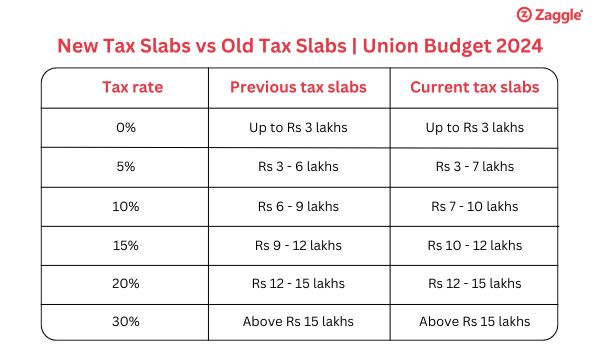Indian Finance Minister Nirmala Sitharaman has presented the Union Budget 2024 amidst big expectations and hopes. Experts are touting the financial bill as a ‘holistic growth engine’. The Budget 2024 highlights the government’s focus on the startup industry, skill development, and women empowerment. For salaried professionals, it brings a major relief as the budget announces favorable tax slabs and increased exemptions. All-in-all, the Union Budget 2024 has made significant updates to existing tax policies including the termination of the angel tax.
Let’s explore new tax regulations in detail.
Brief overview of the Budget 2024
The Government introduced major tax policies in Budget 2023 to primarily push salaried individuals towards a new tax regime. In the current Union Budget 2024, Sitharaman has announced the hike in standard deduction by 50% to Rs 75,000. Additionally, the tax slabs within the new regime have been altered to make it more attractive. However, the tax rates in the old regime remain unchanged.
As per the Budget 2024 highlights, there has been an increase in capital gains tax – both long-term and short-term, which could affect the purchase of investment products like mutual funds.
However, people who are currently submitting their income tax returns don’t need to worry about these changes. The new income tax regulations will come into effect on April 1, 2025, i.e. for the Assessment Year 2025-26.
Impact of the Budget 2024 on salaried individuals
Budget 2024 has provided significant relief to taxpayers in the new tax regime. In effect below are the major changes that will affect salaried professionals.
Increase in Standard Deduction
The latest budget increases the standard deduction by 50% to Rs 75,000, which will reduce the tax budget for the salaried class. The standard deduction refers to the amount that will be removed from the annual salary before calculating the taxable income. It requires no investment proof or documentation. The standard deduction was fixed at Rs 50,000 in 2019-20 and has remained unchanged until now. However, professionals who choose the old tax regime can only avail a deduction of Rs 50,000.
New tax slab rates
The finance ministry has offered better tax rates for salaried individuals opting for the new tax regime as one of the Budget 2024 highlights. However, the changes only widen the tax slabs for those with incomes under Rs 10 lakhs.
While Rs 3 lakhs of taxable income remain tax-free, the Government has widened the gap of the 5% slab to Rs 3 – 7 lakhs from either Rs 3-6 lakh. It will effectively save Rs 5,000 for individuals with income more than Rs 6 lakhs.
The 10% slab, on the other hand, will now cover the incomes between Rs 7 and 10 lakhs, as against earlier Rs 6-9 lakhs. This change will attract savings of Rs 5,000 for those with taxable income of more than ₹7 lakh.
The next slab of 15% has been changed to Rs 10 to 12 lakhs from earlier Rs 9-12 lakhs. The 20% and 30% slabs, however, remain unchanged.
The Finance Ministry stated that these new slabs will result in savings of Rs 17,500 by reducing the overall tax liability of the salaried class.

Benefits of the new tax slab rates
- The new tax regulations introduced in Budget 2024 will put more money in the hands of salaried professionals. A total of Rs 17,500 can be reduced in tax liabilities by considering both increased standard deduction and widening of tax slabs.
- The tax brackets have been lowered for middle-income earners and professionals to reduce their tax burden.
- With tax savings added to their salaries, individuals will have more purchasing power, which will improve their lifestyle, while also boosting consumption. This is critical for economic vitality.
- The attractive tax rates and simplicity of the new tax regime can bring more people within the tax fold by making the entire process simpler.
Tips for Effective Tax Planning
With the new regulations coming into effect next year, you still have time to make an efficient tax plan. Below are some tips that will make the process easy.
- Evaluate both regimes
One of the budget 2024 highlights are the new tax slabs in the new tax regime. However, it offers fewer deductions when compared to the old regime. Therefore, you must calculate your tax obligations under both regimes and then choose the one that provides better savings based on your individual needs.
- Understand new tax slabs
To understand your tax liability accurately, you must be familiar with tax brackets and how they are applied. As per the revised slabs, there is no tax on income up to Rs 3 lakhs and a maximum tax rate of 30% for income above Rs 15 lakhs. However, the tax calculation is not as straightforward.
For example, if your annual income is Rs 10 lakhs after all the deductions, this is how your tax liability is calculated as per the new tax regime.
- For the first Rs 3 lakhs, you pay zero tax.
- For the next Rs 4 lakhs, you pay 5% tax i.e. Rs 20,000
- For the remaining Rs 3 lakh, you pay 10% tax i.e. Rs 30,000
Therefore your total payable tax is Rs 50,000.
| Tax Rate | Current Tax Slabs | Your Tax Outgo |
| 0% | Up to Rs 3 lakhs | Nil |
| 5% | Rs 3 – 7 lakhs | 20000 |
| 10% | Rs 7 – 10 lakhs | 30000 |
- Leverage all deductions
Depending on the tax regime you choose, make sure you assess all the deductions and exemptions applicable to you. These deductions are critical in lowering your taxable income and increasing savings. Take a look at different investment and retirement savings schemes that reduce your tax outgo.
- Claim tax rebate for lower incomes
If your annual income is up to Rs 7 lakh, you can claim a benefit of tax rebate of up to Rs 25,000. This scheme can effectively make your taxable income zero. This rebate was increased from Rs 12,500 in the last year’s budget. So make sure you take this into account.
- Plan for capital gains
The Budget 2024 has revised the tax on capital gains for both short-term and long-term. If you are planning to sell your assets, evaluate how it will affect your tax liability.
- Plan for future income
Since this is a quarter where salaries are revised and annual hikes are reflected in the income, you might want to factor this into your tax planning. You can avoid any last-minute surprises by adjusting your contributions to savings schemes.
- Get your documentation in place
To have streamlined and uneventful tax submissions, you must maintain records and documentation of your income, deductions, and investments that could factor in your tax compliance.
Optimize your taxable income for greater savings
The Union Budget 2024 has been long-awaited and followed the interim budget which had almost no change in tax regulations. In the current budget 2024 highlights, the Finance Minister made subtle and significant changes in the direct tax policies.
The government has been pushing the new tax regime by making it a cheaper and more attractive option. It introduced measures like hiking standard deduction from Rs 50,000 to Rs 75,000 and widening tax slabs in the new tax regime. These revisions may not reduce tax outgo for everyone.
Professionals opting for the old tax regime can reduce their tax obligations through exemptions like meal allowances, leave travel allowances, and so on. Employers can offer these tax-saving options through a flexi-benefits program.
Using an intuitive and robust employee benefits platform like Zaggle SAVE can help companies automate flexible benefits programs. Zaggle SAVE is a new-age benefits management solution that allows HR leaders to streamline the disbursement of tax-savings benefits without hassle or operational overhead.
Learn more about Zaggle SAVE here.


